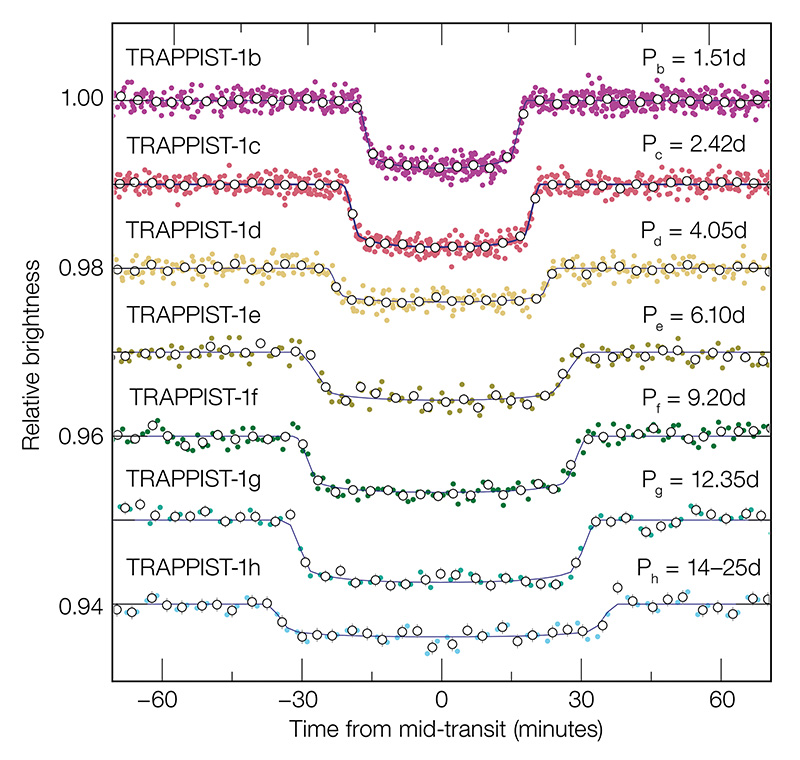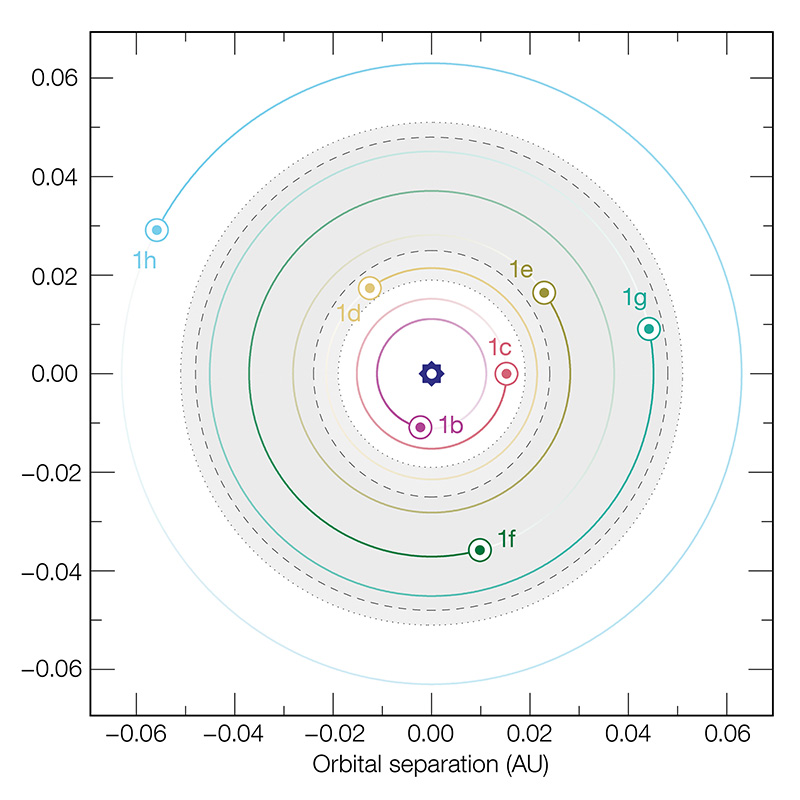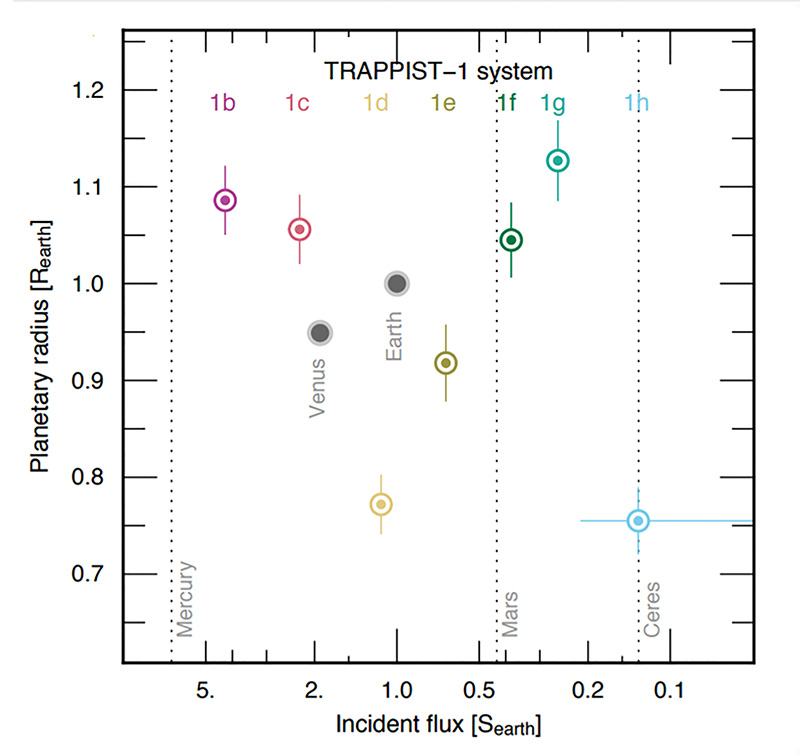TRAPPIST-1: Just right?
Fall
2017
Feature
TRAPPIST-1: Just right?
Elisabeth Matthews, Phd Candidate, University of Exeter, Astrobites Contributor

Back on May 12th, 2016, the discovery of three planets around the star TRAPPIST-1 was announced—in classic imaginative astronomer fashion, the planets were named b, c and d. It was a big deal, leading to a Nature paper, a NASA press release, and some speedy follow-up work taking a look at the atmospheres of b and c. The atmospheric studies confirmed that these two planets don’t host puffy and hydrogen/helium dominated atmospheres. This is notable, as a puffy hydrogen or helium atmosphere would make the planet uninhabitable. Incidentally, these were the first ever Earth-sized planets to have their atmospheres studied.
TRAPPIST-1 is an exciting system as it’s basically right in our astrophysical backyard: extremely close to us, at just 12 parsecs. For reference, even Alpha Centauri, the nearest star system to us, is 1.34 parsecs away. Not only does this make the system feel tangible, it also makes follow-up and characterization work much easier to carry out.
New planets!
As you may have read already, the new Nature paper that we’re discussing in this bite confirms the presence of several more planets in the TRAPPIST-1 system. The system now boasts seven planets, with orbital periods between 1.5 and 12 days. These planets are all confirmed directly by observing their transits—the dips of light as the planets pass directly in front of the star and block a small amount of the star’s light. These can be seen in Figure 1. The first two planets, b and c, are the same as in the previous paper. The authors do find, however, that the two transits previously ascribed to the d planet are actually two different planets! An extended period of observations from various ground- and space-based observatories confirms the presence of four different planets: d, e, f and g. Finally, a potential seventh planet, h, is also observed—but only one transit of this planet is seen, so it is a more tentative detection. Bored of the alphabet yet? Figure 2 shows the planets graphically instead.
Planet tug-of-war
Dynamically, it’s very interesting to observe such a tightly packed system. For context, if the system was superimposed on our own system, all seven planets would all be closer than Mercury. The planets orbit in a so-called mean motion resonance, where the orbits of neighboring planets are all small-integer ratios (b to c is 8/5, c to d is 5/3, etc.) and their closely matched orbits likely stabilize each other. These dynamic interactions mean that strong Transit Timing Variations (TTVs) are observed. In other words, the transits happen up to half an hour ‘early’ or ‘late’ on each individual orbit, as they are pulled and pushed by their neighboring planets. This is useful to us, since it allows the masses to be measured. Without the TTV data, only the radii of each planet could be inferred from the transit data. The first six planets are confirmed to be rocky planets based on their masses and radii, although the composition of h is yet to be determined since only one transit has been observed and this makes the TTV analysis impossible for now!
Water, water everywhere?
This system is particularly exciting as all seven planets are predicted to have equilibrium temperatures in the range where water is liquid. In other words, they’re considered to be in the habitable zone. Exoplanet climatology isn’t quite as simple as all that, though! TRAPPIST-1 is a tiny M-dwarf star, just 8 percent the mass of the Sun. As previously stated, the planets are all in very small orbits, with a full orbit taking 1.5 days for the closest planet and just 12 days for the furthest out planet. Interestingly, the smaller, fainter star coupled with these short orbits means that these planets receive pretty similar levels of radiation from their star as the solar system planets do from the Sun (Figure 3). As the authors point out, planets c, d and e are exposed to very similar levels of radiation as Venus, Earth and Mars, respectively.
Since the planets are all so close to their star and are in such close proximity, they are likely tidally locked, as is the case for hot Jupiter type systems. In addition, the authors of the paper simulate the climates of each planet. They find that the b, c and d planets are all likely to undergo a runaway greenhouse scenario. The further out planets e, f and g, however, appear able to harbor water oceans. Even on the inner planets—b, c and d—it is possible that there is some liquid water on limited regions of the surface.
Before you get too excited, it’s worth noting that Venus, Mars and Earth are all in the ‘habitable zone’ of the Sun—just like these TRAPPIST-1 planets. As you’ve probably noticed, Earth is habitable but Venus and Mars are both pretty unpleasant, with Venus hosting sulfuric acid clouds and Mars plummeting to -73 Celsius at night. Check out the astrobites article at https://astrobites.org/2011/12/07/venus-as-a-non-habitable-exoplanet/ for more analysis of ‘Venus as an exoplanet’.

So, what next?
As it happens, the Kepler Observatory is actually staring at this system right now: it has a 70-day campaign on this patch of sky, from December 15th 2016 through to March 4th 2017. The Kepler data will be made publicly available immediately after the campaign. Not only does this mean you can get your hands dirty playing with the data if you like, but you can also bet that several exoplanet teams around the world will be itching to do some of their own analysis. We’re certainly likely to be hearing more science from the system soon!
The James Webb Space Telescope will almost certainly have a go at characterizing these atmospheres after it launches in 2018. However, this is going to be hard work. David Wilson wrote an Astrobite (https://astrobites.org/2016/05/26/searching-for-signs-of-life-with-the-j...) about the difficulties observing the atmospheres of TRAPPIST-1 b and c, and the situation for the new planets is likely to be similar.
SETI, the Search for Extra-Terrestrial Intelligence, has already pointed its antennae towards TRAPPIST-1, just in case there are aliens trying to talk to us. Of course, the success of this mission would rely on (a) the planets being habitable, (b) the planets being inhabited, (c) the alien life having evolved to intelligence and (d) that intelligence emitting the sort of signals SETI look for. Well, it’s worth a shot, anyway!
Looking further ahead, next-generation ground-based telescopes like the European Extremely Large Telescope, set to be completed in 2025, will be able to detect water on these planets and carry out further atmospheric characterization.
It’s certainly clear that TRAPPIST-1 will be under a lot more scrutiny in the near future!

-------------
This summary originally appeared in Astrobites on Feb 22, 2017, https://astrobites.org/2017/02/22/trappist-1-just-right/.
Paper Title: “Seven temperate terrestrial planets around the nearby ultracool dwarf star TRAPPIST-1”
Authors: Michaël Gillon, Amaury H. M. J. Triaud, Brice-Olivier Demory et al.
First Author’s Institution: Space Sciences, Technologies and Astrophysics Research (STAR) Institute, Université de Liège, Belgium
Status: Published in Nature, doi:10.1038/nature21360
